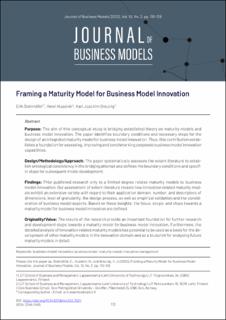| dc.contributor.author | Steinhöfel, Erik | |
| dc.contributor.author | Hussinki, Henri | |
| dc.contributor.author | Breunig, Karl Joachim | |
| dc.date.accessioned | 2022-12-20T08:22:36Z | |
| dc.date.available | 2022-12-20T08:22:36Z | |
| dc.date.created | 2022-10-28T13:21:36Z | |
| dc.date.issued | 2022-11-03 | |
| dc.identifier.citation | Journal of Business Models. 2022, 10 (2), 110-126. | en_US |
| dc.identifier.issn | 2246-2465 | |
| dc.identifier.uri | https://hdl.handle.net/11250/3038718 | |
| dc.description.abstract | Purpose: The aim of this conceptual study is bridging established theory on maturity models and business model innovation. The paper identifies boundary conditions and necessary steps for the design of an integrated maturity model for business model innovation. Thus, this contribution establishes a foundation for assessing, improving and benchmarking corporate business model innovation capabilities.
Design/Methodology/Approach: The paper systematically assesses the extant literature to establish ontological consistency in the bridging attempt and defines the boundary conditions and specific steps for subsequent model development.
Findings: Prior published research only to a limited degree relates maturity models to business model innovation. Our assessment of extant literature reveals how innovation related maturity models exhibit an extensive variety with regard to their application domain, number, and descriptors of dimensions, level of granularity, the design process, as well as empirical validation and the consideration of business model aspects. Based on these insights, the focus, scope, and steps towards a maturity model for business model innovation are defined.
Originality/Value: The results of the research provide an important foundation for further research and development steps towards a maturity model for business model innovation. Furthermore, the detailed analysis of innovation related maturity models has potential to be used as a basis for the development of other maturity models in the innovation domain and as a blueprint for analysing future maturity models in detail. | en_US |
| dc.language.iso | eng | en_US |
| dc.publisher | Aalborg Universitetsforlag | en_US |
| dc.relation.ispartofseries | Journal of Business Models;Vol. 10 No. 2 (2022) | |
| dc.rights | Attribution-NonCommercial-NoDerivatives 4.0 Internasjonal | * |
| dc.rights.uri | http://creativecommons.org/licenses/by-nc-nd/4.0/deed.no | * |
| dc.subject | Business model innovation | en_US |
| dc.subject | Business models | en_US |
| dc.subject | Maturity modela | en_US |
| dc.subject | Innovation management | en_US |
| dc.title | Framing a Maturity Model for Business Model Innovation | en_US |
| dc.type | Peer reviewed | en_US |
| dc.type | Journal article | en_US |
| dc.description.version | publishedVersion | en_US |
| cristin.ispublished | true | |
| cristin.fulltext | original | |
| cristin.qualitycode | 1 | |
| dc.identifier.doi | https://doi.org/10.54337/jbm.v10i2.7024 | |
| dc.identifier.cristin | 2066050 | |
| dc.source.journal | Journal of Business Models | en_US |
| dc.source.volume | 10 | en_US |
| dc.source.issue | 2 | en_US |
| dc.source.pagenumber | 110-126 | en_US |

